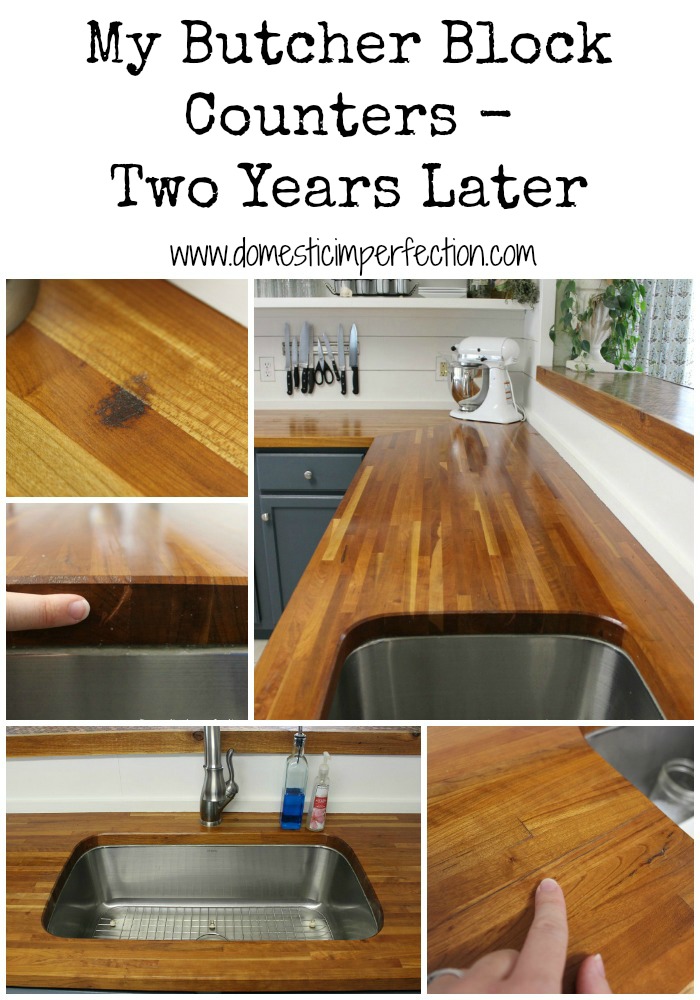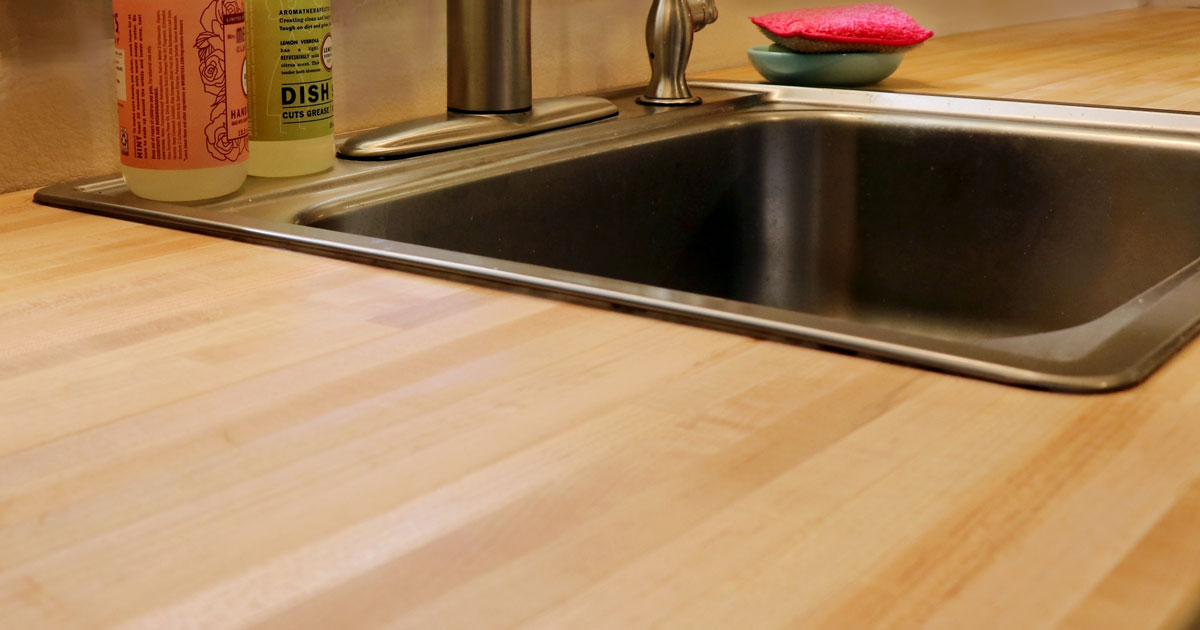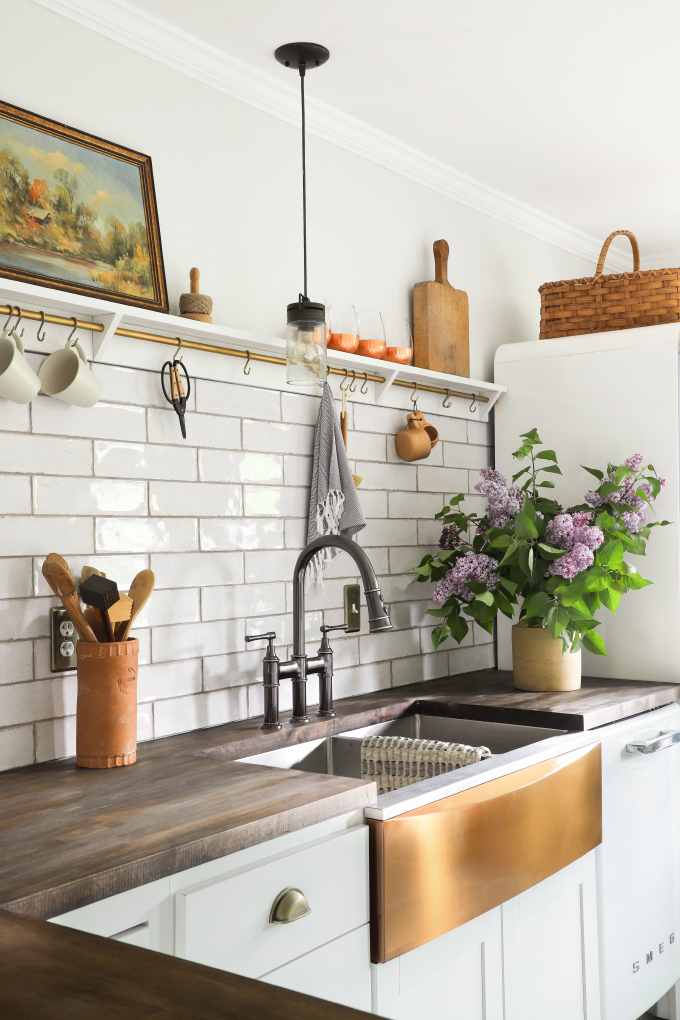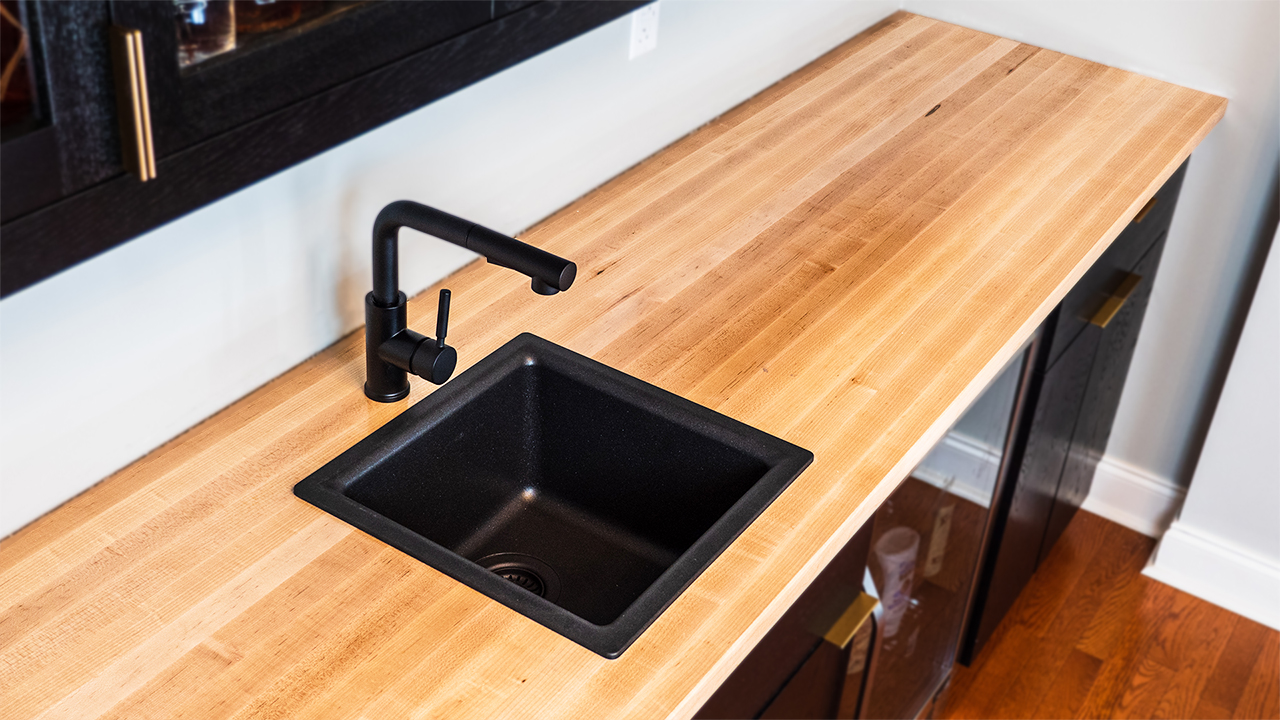Butcher block countertops, known for their warm, rustic appeal and versatility, have become increasingly popular in kitchen design. When combined with a sink, butcher block countertops offer a unique aesthetic that blends the functionality of a working kitchen with the charm of natural wood. However, installing a sink in a butcher block countertop requires careful consideration and proper maintenance to ensure longevity and performance. This type of countertop brings a cozy, inviting atmosphere to the kitchen, making it an ideal choice for those who appreciate the look of natural materials and the craftsmanship involved in their creation.
One of the primary benefits of butcher block countertops is their ability to add warmth and character to a kitchen. Unlike other materials like granite or quartz, butcher block surfaces provide a tactile, organic feel that can make the kitchen feel more welcoming. The natural wood grains, patterns, and color variations give each butcher block countertop a unique appearance, which can be a focal point in any kitchen design. When paired with a sink, the countertop becomes not just a workspace but also a centerpiece that reflects the homeowner’s taste and style.
Butcher block countertops are also known for their durability, particularly when properly maintained. Wood is a resilient material that can withstand daily use, including food preparation, cutting, and chopping. However, the presence of a sink introduces water into the equation, which can pose a risk to the wood if not managed correctly. To prevent water damage, it’s essential to properly seal the countertop around the sink area. This creates a moisture-resistant barrier that helps protect the wood from swelling, warping, or cracking over time.
The choice of wood species for a butcher block countertop can significantly impact its performance and appearance. Hardwoods like maple, oak, cherry, and walnut are popular choices due to their strength, density, and ability to resist dents and scratches. Maple, for example, is often chosen for its light color and fine grain, which gives it a clean, contemporary look. Walnut, on the other hand, offers a rich, dark hue with distinctive grain patterns that add depth and sophistication to the kitchen. Each wood species has its characteristics, so selecting the right one depends on your design preferences and how you plan to use the countertop.

When integrating a sink into a butcher block countertop, the type of sink and its installation method are critical considerations. Undermount sinks, where the sink is installed beneath the countertop surface, are a popular choice for butcher block countertops. This installation method creates a seamless look and makes it easy to wipe water and debris directly into the sink without encountering any edges. However, it’s essential to ensure that the edges of the cutout are thoroughly sealed to prevent water from seeping into the wood. Drop-in sinks, which sit on top of the countertop, can also be used, but they may require additional sealing around the edges to protect the wood from moisture.
Maintenance is key to preserving the beauty and functionality of a butcher block countertop, especially around the sink area. Regular oiling is recommended to keep the wood hydrated and to enhance its natural resistance to moisture. Mineral oil is commonly used for this purpose, as it penetrates the wood and helps to maintain its flexibility. For countertops that are exposed to water frequently, such as those with a sink, it may be necessary to oil the surface more often to ensure that the wood remains protected. In addition to oiling, cleaning the countertop with a mild soap and water solution, and avoiding harsh chemicals, will help maintain its appearance.
Another advantage of butcher block countertops is their ability to be refinished if they become damaged or worn over time. Unlike stone or laminate surfaces, which may need to be replaced if scratched or chipped, butcher block countertops can be sanded down and re-oiled to restore their original beauty. This makes them a long-lasting option that can evolve with your kitchen over the years. However, it’s important to address any water damage or stains promptly, as these issues can become more difficult to repair if left untreated.

The integration of a sink into a butcher block countertop can also influence the overall design and functionality of the kitchen. For example, incorporating a farmhouse or apron-front sink into the butcher block can enhance the rustic charm of the space while providing ample space for washing large pots and pans. This type of sink pairs beautifully with the natural look of wood, creating a cohesive and inviting kitchen environment. Alternatively, a sleek stainless steel or composite sink can provide a modern contrast to the warmth of the wood, offering a blend of traditional and contemporary styles.
While butcher block countertops with a sink offer many benefits, they also require careful planning during the installation process. Ensuring that the countertop is properly supported and that the sink is securely mounted is crucial to preventing issues down the line. The weight of the sink, especially when filled with water, can put additional strain on the countertop, so reinforcing the cabinetry or adding brackets may be necessary. Additionally, it’s important to account for the expansion and contraction of the wood due to changes in temperature and humidity, which can affect the fit and finish of the sink installation.
Another factor to consider when choosing a butcher block countertop with a sink is the overall kitchen workflow. Butcher block countertops are ideal for food preparation, particularly for tasks like chopping and cutting. By placing the sink near a designated prep area, you can create an efficient workspace that allows for easy cleanup and food handling. This setup is especially beneficial in busy kitchens where multitasking is common, as it enables a smooth transition from preparation to washing without moving across the kitchen.
Butcher block countertops also offer a level of versatility that is unmatched by many other materials. They can be left unfinished for a more natural, rustic look, or they can be stained or treated to achieve a specific color or finish that complements the rest of the kitchen. This flexibility allows homeowners to customize their countertops to match their exact design vision. In addition, butcher block can be used not only for countertops but also for islands, cutting boards, and other kitchen surfaces, creating a cohesive and unified look throughout the space.
While the natural beauty of butcher block countertops is undeniable, it’s important to recognize the ongoing maintenance that is required to keep them in top condition. Regular cleaning, oiling, and sealing are necessary to protect the wood from water damage, stains, and other wear and tear. For those who appreciate the look and feel of natural wood and are willing to invest time in its upkeep, a butcher block countertop with a sink can be a rewarding and long-lasting addition to the kitchen.
Ultimately, the decision to install a butcher block countertop with a sink comes down to a balance of aesthetics, functionality, and maintenance. While these countertops offer a unique and attractive option for the kitchen, they require a commitment to proper care and maintenance to ensure they remain beautiful and functional over time. By understanding the characteristics of butcher block countertops and taking the necessary steps to protect them, homeowners can enjoy the warmth and charm that this material brings to their kitchen for many years to come.

Common Mistakes to Avoid
Improper Sealing Around the Sink: One of the most common mistakes is failing to properly seal the area around the sink. Water can seep into the wood, causing it to swell, warp, or crack. Ensure that the edges of the sink cutout are thoroughly sealed with a waterproof sealant to prevent moisture damage.
Neglecting Regular Maintenance: Butcher block countertops require regular maintenance, including oiling and cleaning. Neglecting this maintenance can lead to a dry, brittle surface that is more prone to damage. Make a routine of oiling the countertop to keep the wood hydrated and protected.
Using Harsh Cleaning Products: Harsh chemicals and abrasive cleaners can damage the wood surface, stripping away its natural oils and causing it to deteriorate over time. Stick to mild soaps and water for cleaning, and avoid products that contain bleach or ammonia.
Placing Hot Pots Directly on the Countertop: Wood is sensitive to heat, and placing hot pots or pans directly on the countertop can cause burns or discoloration. Always use trivets or hot pads to protect the wood from heat damage.
Not Considering Wood Movement: Wood naturally expands and contracts with changes in temperature and humidity. Failing to account for this movement during installation can result in gaps, cracks, or warping around the sink area. Ensure that there is adequate room for the wood to expand and contract without causing damage.
Overlooking Cabinet Support: Butcher block countertops, especially when combined with a sink, can be heavy. It’s important to ensure that the underlying cabinets are strong enough to support the weight. Reinforce the cabinetry if necessary to prevent sagging or structural issues.

How do I maintain a butcher block countertop with a sink?
Maintaining a butcher block countertop with a sink involves regular cleaning and oiling. Clean the countertop daily with a mild soap and water solution, and avoid harsh chemicals that can damage the wood. To keep the wood hydrated and resistant to moisture, apply mineral oil or a food-safe wood conditioner every few weeks, especially around the sink area where water exposure is frequent. Proper maintenance will help protect the wood from water damage, stains, and wear, ensuring your countertop remains beautiful and functional over time.
Can I install a butcher block countertop with a sink myself?
While it’s possible to install a butcher block countertop with a sink as a DIY project, it requires careful planning and precision. The countertop must be cut accurately to fit the sink, and the edges need to be sealed properly to prevent water damage. Additionally, the countertop and sink must be securely supported to handle the weight. If you have experience with carpentry and plumbing, you might be able to complete the installation yourself. However, for the best results and to avoid potential issues, hiring a professional installer is recommended.
What wood species is best for a butcher block countertop with a sink?
Hardwoods such as maple, oak, walnut, and cherry are popular choices for butcher block countertops due to their durability and resistance to dents and scratches. Maple is a common choice for its light color and fine grain, which provides a clean, contemporary look. Walnut offers a rich, dark hue with striking grain patterns, adding depth and sophistication to the kitchen. The choice of wood species depends on your design preferences and how you plan to use the countertop. Consider how the wood’s color and grain will complement the rest of your kitchen décor.

How do I prevent water damage to my butcher block countertop around the sink?
To prevent water damage to your butcher block countertop around the sink, it’s crucial to seal the edges of the sink cutout with a waterproof sealant. This creates a barrier that protects the wood from moisture. Additionally, regular oiling of the countertop will help maintain the wood’s natural resistance to water. After using the sink, wipe down the surrounding area to remove any standing water. By taking these precautions, you can minimize the risk of water damage and prolong the life of your butcher block countertop.
Can I refinish a butcher block countertop if it gets damaged?
Yes, one of the advantages of butcher block countertops is that they can be refinished if they become damaged or worn. If your countertop develops scratches, stains, or water damage, you can sand down the affected area to remove the imperfections and then re-oil the surface. This process can restore the countertop to its original beauty. Refinishing is a cost-effective way to extend the life of your butcher block countertop, making it a long-lasting investment for your kitchen.
Are butcher block countertops with sinks suitable for all kitchens?
Butcher block countertops with sinks are suitable for many kitchens, but they require a commitment to regular maintenance. If you appreciate the natural beauty of wood and are willing to invest time in its care, a butcher block countertop can be a rewarding choice that adds warmth and character to your kitchen. However, if you prefer a low-maintenance surface, you might want to consider other countertop materials. Additionally, the design and layout of your kitchen should accommodate the weight and requirements of a butcher block countertop with a sink to ensure functionality and longevity.

How to Treat Water Spots on Butcher Block Counters

DIY Butcher Block Countertops Oh, yes you can!

Related articles:
- Mahogany Butcher Block Countertops
- Butcher Block Countertop For Kitchen Island
- Can You Paint Butcher Block Countertops
- Butcher Block Countertops With White Cabinets
- Pine Butcher Block Countertops
- Butcher Block Countertops Walnut
- Maple Butcher Block Countertops
- Care Of Butcher Block Countertop
- Butcher Block Countertops Maintenance
- Antique Butcher Block Countertops